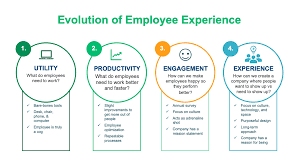Employee Engagement
Employee engagement is the extent to which employees feel passionate about their jobs, are committed to the organization and put discretionary effort into their work. It is not the same as employee satisfaction, which only indicates how happy, or content employees are. Nor is the same as employee experience, which is the process, and the journey employees take with the business.
What they all do have in common is a direct correlation in which HR professionals and business leaders need to create robust employee processes and healthy relationships to promote a positive workplace environment where employees feel happy and satisfied, which leads them to work hard to realize personal team and business goals.
As businesses continue to recognize people as their greatest assets, they are choosing to invest in employee experience which encapsulates what people encounter and observe in the workplace. It can be described as what the culture feels like to employees. It isn't what you say it is or is not. It's what employees experience through interactions with other employees, technologies and the work itself.
With unprecedented changes toward society, economy and businesses, employers are paying more attention to the way employees experience work. This shift is becoming so prevalent that there is an emergence of departments and positions dedicated to this work. The employee experience equation can be summarized as the combination of three environments. Culture, how we feel about work. Technology, what is used for working, and the Workspace, where work gets done.
Underlining the entire process is consistent communication and eliciting regular feedback to craft a dynamic employee experience. For businesses to be successful, they need to focus on each of these environments. They must create spaces where employees want to show up, instead of where they need to show up.
Employee experiences happen over work tenure and will impact both professional and personal experiences.
The professional experiences we’re referring to are onboarding, knowledge transfer, project work, collaboration, and promotion. And the personal experiences are relocation, new child, and retirement. They contribute to how an employee feels about work and require the employer to address both perspectives.
Employee experience and its relationship with employee engagement are critical to understand and prioritize. Research has shown that when businesses get employee experience right, they can achieve twice that customer satisfaction and innovation and generate 25% higher profits than those who don’t. The employee experience constitutes the entire journey an employee takes through the employee lifecycle. It proactively shapes what will happen.
An employees' experience of work drives their level of engagement. Employee engagement measures the degree to which an employee is willing and able to do their best at work. It is a byproduct and outcome of the employee's experience at work.
Creating a positive employee experience is imperative for business, and it should be a conscious, evolving organizational focus which strives for happy, internally motivated employees. Here are four fundamental principles.
Utility, this gives employees what they need to work, is made up of bare-bone tools, furniture and equipment.
Productivity, this gets employees what they need to work better and faster. A slight improvement can get more out of employees, so employee optimization and repeatable processes are critical to the success.
Engagement, this makes employees happy, so they perform better. It acts as an adrenaline shot with a focus on culture. Typically, annual surveys are used as a measurement tool.
Experience, this plans for employees to want to show up versus a need to show up. It focuses on culture, technology, and space with a purposeful design and a long-term approach.
The research on engagement supports what most of us already know intuitively. Employees are more engaged when employers value their contributions and communicate that value in specific visible ways. Engagement matters because engaged employees are more productive workers. Businesses with successful engagement strategies enjoy 33% higher profits and 51% lower turnover rates. Increased employment engagement can be achieved with an intentional strategy with specific, actionable goals.
- - - -
EEO-1 Filing Period (May 20- Jun 24)
The EEO-1 Component 1 Report is a mandatory annual data collection, submitted to the U.S. Equal Employment Opportunity Commission (EEOC). It requires certain employers to report workforce demographic data by race/ethnicity, sex, and job category. The purpose is to support the enforcement of federal equal employment opportunity (EEO) laws and help identify employment patterns.
Who Is Required to File?The following employers must file an EEO-1 Component 1 Report annually:
- Private employers with 100 or more employees
- Federal contractors (and first-tier subcontractors) with 50 or more employees and a federal contract, subcontract, or purchase order worth $50,000 or more
- Multi-establishment employers (with more than one physical location) must submit additional reports for each location
What Information Must Be Reported?Employers must report employee data as of a “workforce snapshot period” (a pay period between October 1 and December 31 of the reporting year), including:
- Number of employees by race/ethnicity
- Number of employees by sex
- Number of employees by job category (e.g., Executive/Senior Level Officials, Professionals, Technicians, etc.)
Key Dates & DeadlinesThe filing period generally opens in the spring of the following year (e.g., 2024 data due in 2025). Deadlines and updates are posted on the EEOC’s EEO-1 website.
Compliance Tips
- Review job classifications using the EEO-1 job category definitions
- Use self-identification forms during onboarding to collect race/ethnicity and gender data.
- Maintain accurate HRIS data and ensure consistency across all establishments.
- Designate a point person or team responsible for data collection and timely submission.
- - - -
Contact HR Strategies at 302.376.8595 or info@hrstrategies.org if you would like support or would like to learn more about the items in this newsletter. Please contact us if you would like to be added to our Monthly Strategies mailing list or if you would like for us to add someone to our mailing list.


